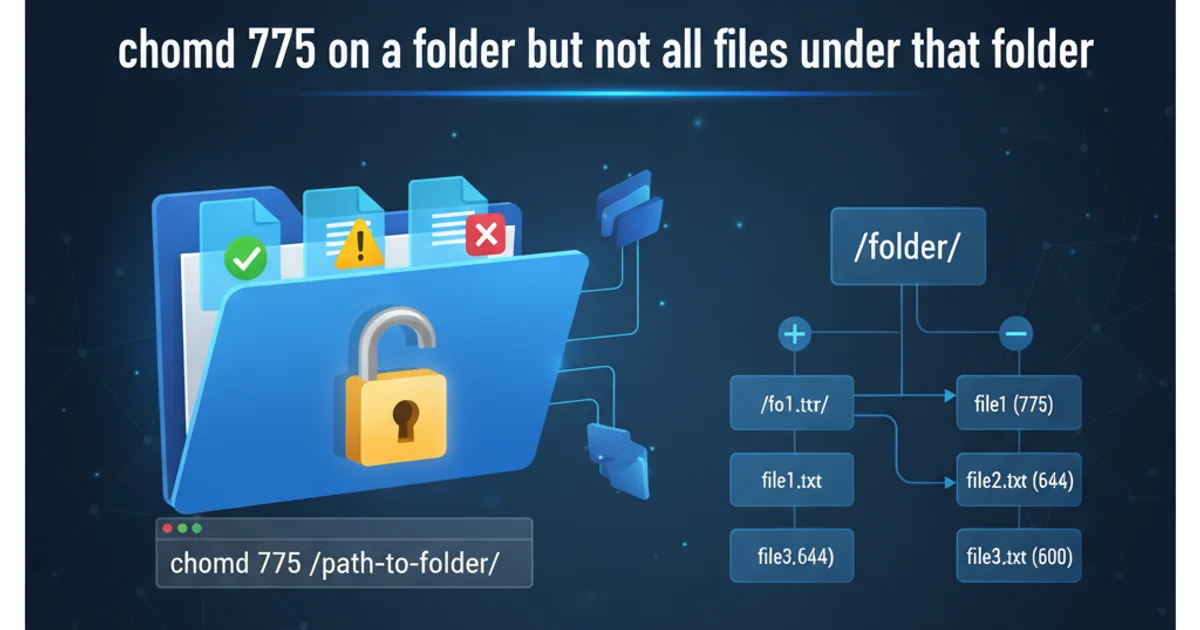chmod 775 on a folder but not all files under that folder
Categories:
Mastering File Permissions: Applying chmod 775 to Folders, Not Files

Learn how to correctly apply chmod 775 to directories while preserving existing file permissions within them, a common task in Unix-like systems for managing access control.
Managing file and directory permissions is a fundamental aspect of Unix-like operating systems. The chmod command is your primary tool for this, allowing you to control who can read, write, and execute files and directories. A common scenario involves setting specific permissions for a directory, such as 775, to allow group write access, but not applying those same permissions to all files within that directory. This article will guide you through the correct methods to achieve this, ensuring your directories have the desired permissions while leaving file permissions untouched or setting them appropriately.
Understanding chmod and Permissions
Before diving into the commands, let's quickly review what chmod 775 means and how permissions work. Permissions are represented by a three-digit octal number, where each digit corresponds to user, group, and others, respectively. Each digit is a sum of read (4), write (2), and execute (1) permissions.
- 7 (rwx): Read, write, and execute permissions.
- 5 (r-x): Read and execute permissions.
So, chmod 775 translates to:
- User (owner): Read, write, and execute (7)
- Group: Read, write, and execute (7)
- Others: Read and execute (5)
When applied to a directory, 'execute' permission allows you to enter or traverse the directory. For files, 'execute' means you can run the file (if it's a script or executable program).
flowchart TD
A[chmod 775] --> B{Target: Directory or File?}
B -->|Directory| C[User: rwx]
B -->|Directory| D[Group: rwx]
B -->|Directory| E[Others: r-x]
B -->|File| F[User: rwx]
B -->|File| G[Group: rwx]
B -->|File| H[Others: r-x]
C --> I[Allows traversal, creation/deletion of files]
D --> I
E --> I
F --> J[Allows execution]
G --> J
H --> JUnderstanding chmod 775 permissions for directories and files.
Applying Permissions to Directories Only
The key to applying chmod 775 to a folder without affecting its contents is to use the -type d option with the find command. This allows you to specifically target directories and exclude files. The find command is powerful for locating files and directories based on various criteria and then executing commands on them.
find /path/to/your/folder -type d -exec chmod 775 {} \;
Applying chmod 775 to directories only within a specified path.
Let's break down this command:
find /path/to/your/folder: Specifies the starting directory for the search.-type d: This crucial option tellsfindto only consider directories.-exec chmod 775 {} \;: For each directory found, execute thechmod 775command.{}is a placeholder for the current directory found byfind, and\;terminates the-execcommand.
find commands without the -exec part first to ensure it's selecting the correct files/directories. For example, find /path/to/your/folder -type d will list all directories it would operate on.Setting Default Permissions for New Files and Directories (umask)
While chmod modifies existing permissions, umask controls the default permissions for newly created files and directories. Understanding umask can help prevent future permission issues.
A umask value is subtracted from the default maximum permissions. For directories, the maximum is 777 (rwxrwxrwx). For files, the maximum is 666 (rw-rw-rw-), as execute permission is typically not granted by default.
For example, a umask of 002 (common for shared environments) means:
- Directories:
777 - 002 = 775 - Files:
666 - 002 = 664
To temporarily set your umask for the current session, you can use the umask command. To make it permanent, you'd typically add it to your shell's configuration file (e.g., ~/.bashrc, ~/.profile).
# View current umask
umask
# Set umask to 002 (new directories will be 775, new files 664)
umask 002
Checking and setting the umask value.
umask globally, especially on production systems, as it affects all new files and directories created by that user or process.1. Identify the Target Folder
Determine the absolute path to the folder where you want to apply chmod 775 to its directories.
2. Preview Directories to be Modified
Run find /path/to/your/folder -type d to see a list of all directories that will be affected. This helps prevent unintended changes.
3. Apply chmod to Directories
Execute the command find /path/to/your/folder -type d -exec chmod 775 {} \; to set the desired permissions on all directories within the specified path, leaving files untouched.
4. Verify Permissions
Use ls -ld /path/to/your/folder and ls -ld /path/to/your/folder/subdirectory to confirm that the directories now have drwxrwxr-x permissions. Also, check a sample file's permissions using ls -l /path/to/your/folder/file.txt to ensure they were not changed.